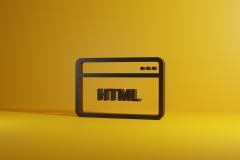Module 1: Introduction to HTML
- Lesson 1: Understanding the Basics of HTML
- Lesson 2: Setting Up Your Development Environment
- Lesson 3: Creating Your First HTML Document
Module 2: HTML Document Structure
- Lesson 1: Structure of an HTML Document
- Lesson 2: Head and Body Elements
- Lesson 3: Text Formatting with Headings and Paragraphs
Module 3: Working with Text and Links
- Lesson 1: Adding Text and Comments
- Lesson 2: Creating Hyperlinks
- Lesson 3: Linking to External Websites
Module 4: Lists and Images
- Lesson 1: Creating Unordered and Ordered Lists
- Lesson 2: Adding Images to Your Web Page
- Lesson 3: Image Attributes and Best Practices
Module 5: Forms and Input
- Lesson 1: Building Forms in HTML
- Lesson 2: Input Elements (Text, Radio, Checkbox, etc.)
- Lesson 3: Form Submission and Handling
Module 6: Tables and Semantic HTML
- Lesson 1: Creating Tables
- Lesson 2: Adding Headers and Captions
- Lesson 3: Semantic HTML Elements (e.g.,
,)
Module 7: HTML5 and Multimedia
- Lesson 1: HTML5 Semantic Elements (e.g.,
,) - Lesson 2: Embedding Audio and Video
- Lesson 3: Creating Canvas for Graphics
Module 8: HTML Forms and Validation
- Lesson 1: Form Input Types (e.g., email, number)
- Lesson 2: HTML5 Form Validation
- Lesson 3: Customizing Form Styles
Module 9: Accessibility and Best Practices
- Lesson 1: Understanding Web Accessibility
- Lesson 2: Semantic Markup for Accessibility
- Lesson 3: Testing and Validating Your HTML
Module 10: Hosting and Publishing
- Lesson 1: Choosing a Web Hosting Service
- Lesson 2: Uploading Your HTML Files
- Lesson 3: Domain Setup and Deployment
Module 11: Advanced Topics (Optional)
- Lesson 1: Introduction to HTML5 APIs (e.g., Geolocation, Local Storage)
- Lesson 2: Introduction to JavaScript and its Integration with HTML
Module 12: Final Project
- Create a simple, well-structured HTML webpage.
Assessment:
- Quizzes and small assignments after each module.
- A final project to demonstrate your HTML skills.
This curriculum will provide you with a strong foundation in HTML, allowing you to create web content and understand the structural aspects of web development. As you progress, you can explore more advanced web technologies and languages like CSS and JavaScript to further enhance your web development skills.






